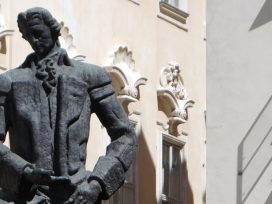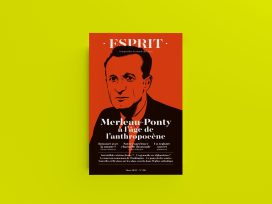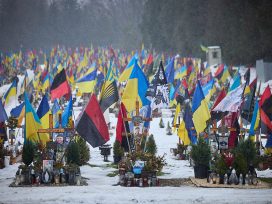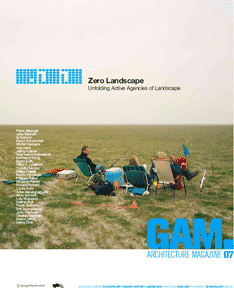 Klaus K. Loenhart: For the Zero Landscape edition of GAM, landscape and the environment, often perceived as the seemingly passive background to our cultural endeavours, are elevated to the status of a protagonist. In your own work “on the seemingly passive”, how did you arrive at your position of a political ecology of things and matter?
Klaus K. Loenhart: For the Zero Landscape edition of GAM, landscape and the environment, often perceived as the seemingly passive background to our cultural endeavours, are elevated to the status of a protagonist. In your own work “on the seemingly passive”, how did you arrive at your position of a political ecology of things and matter?
Jane Bennett: Prior to reading GAM’s call for papers, I had not focused on the sensibility-shaping powers of the category “landscape”. But of course “landscape” (like “environment”) has presented the world as naturally divided into active bodies (life) and passive contexts (matter). I think many people now find this picture implausible. For us, landscape is better understood as an “assemblage” or working set of vibrant materialities. In Vibrant Matter I inflected Deleuze and Guattari’s notion of assemblage in this way: “Assemblages are living, throbbing confederations that are able to function despite the persistent presence of energies that confound them from within. They have uneven topographies, because some of the points at which the various affects and bodies cross paths are more heavily trafficked than others… Each member of the assemblage has a certain vital force, but there is also an effectivity proper to the grouping as such: an agency of the assemblage”. Clearly, a landscape possesses an efficacy of its own, a liveliness intermeshed with human agency. Clearly, the scape of the land is more than a geo-physical surface upon which events play out. Clearly, a particular configuration of plants, buildings, mounds, winds, rocks, moods does not operate simply as a tableau for actions whose impetus comes from elsewhere.
You ask how it came to pass that it now seems to me wrong (not morally wrong but perceptually imprecise) to speak as if materiality or landscape were mere matter. No one knows exactly how one comes to believe and perceive as one does, but I’ll give it a try, speaking first of a biographical factor, and then naming some literary-philosophical influences.
The biographical factor is madness in my immediate family. Many years of failed attempts to convince, cajole, trick or force my brother (diagnosed as “paranoid schizophrenic”) to pursue more acceptable behaviours has taught me humility in the face of the agency of strange bodily assemblages. It revealed in an uncompromising fashion how dependent rational, communicable thought is upon a fortuitously congenial organization of various, very powerful materials of the body. Living alongside madness erased for me the figure of matter as essentially inanimate stuff; it was no longer possible, for instance, to think of the human body as a “landscape” for the exercise of “will”. Body appears instead as a tangled composite of various active forces, one of which is called will and many of which are only moderately, if at all, susceptible to deliberate reformation.
Madness offers painfully strong evidence of the active powers of flesh, and this renders me more alert to, better sensitized toward, the vitality of materiality per se, including both natural and artificial complexes. It uncovers a world in which “things” vie alongside (as well as enter into) the workings of human will, intelligence, reason, desire. In other words, what holds true for the human body applies to the body of nature-culture as well: a geo-cultural landscape is no more passive, no more simply a context for action, than is the bodily terrain of my brother.
The first text that spurred what could playfully be called my neo-animist views was Hobbes’ Leviathan, which presented Man as “matter in motion” and human thought as one of the elements in a cascade of material effects. I was shaken by Hobbes’ claim that thoughts share the volatile, mobile, vibratory character of bodies, but the starkness (and too mechanistic) materialism of Hobbes really jolted my anthropocentric prejudices about nature and self. Lucretius’ De Rerum Natura, especially its brief remarks about the swerve (clinamen) in primordial Epicurianism, was also influential; it is nicely highlighting the material tendency to form and repeat patterns, even if its atomism understated the processual quality of configurations. I loved Henry Thoreau’s account of his trek up the mountain Ktaadn, in The Maine Woods, where he speaks of the “Titanic” quality of flesh, and Kafka’s stories (especially Cares of a Family Man and The Castle), which offered me an absurdist acknowledgment that material vitality is not confined to natural objects but resided as well in toys, artefacts, tools, furniture, buildings. Finally, there is Spinoza’s Ethics, with its variegated holism of substance, i.e., his “one-world” (immanent) metaphysics. I confess to being a certain kind of holist myself: not organic holism but the entangled character of complexes, the elements of which simultaneously impinge upon, interpenetrate and exceed one another’s powers. William Connolly describes this beautifully in A World of Becoming. And also Deleuze and Guattari’s A Thousand Plateaus, with its peculiar brand of Spinozism, its eclectic natural-science-infused vocabulary and its courage to say crazy, experimental things.
KKL: Your work is most inclusive in that it accounts for its context of discourse in a conversational way. I understand Vibrant Matter‘s conversational style as a technique or practice to actively do what you so convincingly promote: to assemble and to unfold agency between “things”. As you present it, the intrinsic facets of active materiality seem to have developed and transformed in a lively manner.
JB: There are relative strengths and weaknesses of using a conversational tone to address the “philosophical” themes of materialism, vitalism, the hegemony of the subject-object binary, etc. A strength may be that this tone reminds the writer and the reader alike that grand “ontological” questions – What is matter? What is life? What is it that we have called Nature? – are themselves questions of ordinary, daily life. What explains our collective tendency to “pave paradise and put in a parking lot”? I also try to speak in a way that allows the material force of word-sounds, their ability to induce effects in the bodies of the readers and writers (a tingle of skin, a frown of face, a restlessness of the gaze, a vague or nameable mood), to come to the fore. It was also important to me to find ways to elide or work around the default grammar of description, which tends to present a world of agents and their objects rather than a world in which agency is distributed across an ontologically diverse range of bodies. Because I really do believe that the locus of agency is always an assemblage, it’s important to me to write in a way that invites readers into a collective project – into, that is, an experiment of living with and as vibrant matter. Words are “actants”, as are architectural objects: as Lilli Hollein noted with reference to your Observation Tower on the river Mur, “architecture is a wonderful means of representing, imposing or arousing states of human nature”.
A weakness of the conversational and sometimes eccentric/awkward voice of the book could be a certain slide toward a truistic rhetoric. Some readers have said that Vibrant Matter makes the rather obvious point that things exercise power over us. There is truth to the criticism, but I don’t mind it. Sometimes the obvious gets lost or buried, in academic and (other) ethical-political forms of speech, and is worth repeating.
I’d be interested in hearing what you have to say about the question of the mode of presentation, a question of rhetoric or persuasion, especially since you come from a discipline that is more hospitable than political theory tends to be toward visuality and non-text-based forms of expression and modes of inquiry.
KKL: Within a short genealogy of materialism – from Epicurus to the most recent accounts by Bruno Latour – “What kind of materialist are you…”
JB: I would have to be Michel Foucault to be able to offer even a short genealogy of materialism. Instead, I will name the two pragmatic problems that pushed me in the direction of affirming (and, to the extent that Vibrant Matter is a polemic, preaching) “vital materialism”. The first was the intensification of an alarming trend in American public culture wherein a rise in the invocations by politicians of otherworldly powers (the Judeo-Christian “Almighty” combating “forces of evil”) was paired with the positioning of violence and torture as legitimate tools of state. (William Connolly speaks here of an “evangelical-capitalist resonance machine” and I think that Lucretius, Voltaire, Nietzsche, Foucault and other iconoclasts of piety are right to remind us of the gruesome history of some variants of theism in the West.) This combination moved me to speak on behalf of an ethical outlook that was non-theistic and non-teleological (at least in the strongest sense of telos), to proclaim the possibility that an undesigned order of materiality could nevertheless possess the impressive, dynamic, incalculable, awesome and awful qualities elsewhere ascribed to God or Geist or “the human spirit”. It is materiality that is wondrous.
The second problem was ecological destruction, or the globalizing political economy devoted to extraction and exploitation, waste, commodification, human imperialism and winner-take-all. I am a vital materialist who sees positive, pro-green potential in raising the profile of the fact that any human “I” is itself made up of “its” – of a vast array of originally and to varying degrees persistently nonhuman elements, such as bacteria, metals, ambient sounds, the “trains” of images of other bodies, etc. Here I have been inspired by the straightforwardness of Bruno Latour’s rejection of the anthropocentric bias in the social sciences.
KKL: For some time now an argument has been underway on modernity’s seeming disenchantment with the world where the subject of modernity transcends its natural environment. A subsequent overcoming of the culture/nature divide leads towards a dissolution of modern binaries. But what will be the consequences? Your discourse appears set the stage for a set of protagonists that challenge both subjective ideals as well as natural materialisms.
JB: I take you to be asking about the relationship between, on the one hand, my scepticism about the story of modernity as “disenchanted” and, on the other, my challenge to “both subjective ideals and natural materialisms”. My view is that, contra Weber, modernity is full of sites of (secular) enchantment. By enchantment I mean a mood or affect circulating between human bodies (themselves conceived as complexes of human and nonhuman parts) and the other animal, vegetable, and mineral forces they encounter. I associate enchantment with the feeling of being simultaneously fascinated and unnerved in the presence of something truly wild and generative. The point is that enchantment is not so much a belief as it is an energetic current produced by the encounter between two sets of active materialities, one set congealed into a “self” and one into what is often called the “objects of experience” but is better described, following Latour, as a set of nonhuman “actants”. These vibrant animals, plants, viruses, hurricanes, storms, pharmaceuticals and other technological artefacts vie with, make demands upon, and impede and enable human agency. They make their presence known to us or, one could say, make “calls” to which we are continually responding. The literary-visual-artistic ethical task at hand is, I think, to try to describe just what this “call” is without resorting to the framework of pre-given subjects and objects.
KKL: One path to dissipate ontotheological binaries, such as human/nature, technological/organic, is favouring ecology as the all-inclusive concept. While Slavoj Zizek warns of an unreflected application of this “opium of the masses”, you may argue for another difference (in a purely horizontal juxtaposition of actants) within a cultural ecology – a politics of vital materialism.
JB: Your question prompted me to go back to Zizek’s problematic talk, “Ecology: A New Opium of the Masses”, the gist of which is that there is no politically transformative power left in “ecology” as a rallying cry, and this for three reasons.
First, ecology has succumbed to the capitalist imperative of contemporary life, according to which “political action and consumption become fully merged”. While I agree – who could deny it? – that there is little “subversive edge” to green marketing or to ecology reduced to a “problem of sustainable development”, and that capitalism works ruthlessly and creatively to absorb its opponents, Zizek (deliberately) overstates his case. Can ecology (as a complex system of words, sounds, deeds, affects, narratives, propensities) really ever fully merge into the allegedly totalizing system of capitalism? Here I follow Deleuze and Guattari’s claim that “from the viewpoint of micropolitics, society is defined by its lines of flight […] There is always something that flows or flees, that escapes […] the resonance apparatus, and the overcoding machine. Things that are attributed to a ‘change in values’, to the youth, women, the mad, etc.”
Perhaps this is a question of a strategic choice between a rhetoric of purity (Zizek) and a rhetoric of encouragement. I know many non-duped people, from a mayor of a small green town in Maryland, to community garden activists, to Teach for America employees, to bird watchers and hunters, who find that the idea that humans and nonhumans are profoundly interlinked has the potential to alter the status quo. (See also, to cite just one recent book, Thomas Princen’s Treading Softly.)
Zizek’s second objection to ecology concerns its allegedly necessary reliance on an image of nature as an intrinsically harmonious and moral order, which we can refer to for guidance in organizing a polity. He calls instead for an ecology without nature. But this is precisely what ecologists have been pursuing for a while now, from Michel Serres’ notion of noise in Genesis (1982) to Timothy Morton’s more recent Ecology without Nature (2007). Here Zizek seems behind the times – he reduces any invocation of natura naturans to a secret longing for natura naturata. Thus it is that he can reject all ecological perspectives as valorizing stability and as deeply conservative, i.e., anti-revolutionary. That is his third objection to ecology: ecology is afraid of total, revolutionary change and aims instead to “to freeze the earth’s change, so that its ecology will remain basically the same, thus enabling humanity’s survival… This is why, although ecologists are all the time demanding that we radically change our way of life, underlying this demand is… a deep distrust of change, of development, of progress: every radical change can have the unintended consequence of triggering a catastrophe. It is this distrust that makes ecology the ideal candidate for hegemonic ideology, since it echoes the post-political distrust of large collective acts.”
I think that Zizek is right that ecological thinking tends to harbour a distrust of grand and speedy collective acts. An ecological sensibility proceeds with the idea that all entities, forces, and activities are connected (in a not-fully-determinate way) and thus interventions always produce unanticipated effects that call for a certain degree of anticipatory caution. This caution is perhaps intensified once one acknowledges, as the vital materialist does, that “collective” action includes the actions of nonhuman members.
KKL: In distinction to other materialist thinkers, your objects unfold thing-power foremost in the state of assemblage, which unfolds through a contingency of their co-presence. In Vibrant Matter, you argue that “in this [state of] assemblage, objects appeared as things, that is, as vivid entities not entirely reducible to the contexts in which (human) subjects set them, never entirely exhausted by their semiotics”. At one point, when you argue for a culture of assemblages – “for a cognizant of our embeddedness in a natural-cultural-technological assemblage” – I have to think of landscape (in its multi-dimensionality between matter and idea) as interface for this proposed practice. One example of a vital materialism of our contemporary landscape is your account of infrastructure.
JB: What I tried to do in the book is to take “things” very seriously. This is a project that a group of object-oriented philosophers or “speculative realists” (Graham Harman, Ray Brassier, Ian Hamilton Grant, Quentin Meillassoux, Timothy Morton and others) were also pursuing independently and whose work I am currently exploring. By “things” I mean the ordinary stuff around us that we possess and use, and are possessed and used by.
I experience human agency as the outcome or effect of a certain configuration of human and nonhuman forces. When humans act, they do not exercise exclusively human powers, but express and engage the agency of a variety of other actants – including food, micro-organisms, minerals, artefacts, sounds, bio- and other technologies and so on. There is a difference between a human individual and a stone, but neither considered alone has real agency: the locus of agency is always a human-nonhuman collective. It seems to me here that what is called landscape is a paradigmatic example. One of the things I admire about landscape architects is their knack for being sensitive simultaneously to the sensuous specificity of each discrete element of a landscape (e.g., the “thing-power” of plant material) and to the overall mood-effect of the always-evolving configuration. An assemblage has no sovereignty in the classical sense, for no one of its members can consistently determine its trajectory. The effects generated by an assemblage are emergent in that their ability to make something happen (a blackout, a hurricane, a war on terror, the border to Slovenia) is distinct from the sum of the force of each materiality considered alone.
As you note, one example I work with in the book is the agency behind the widespread electricity blackout in 2003 in North America (and later in the year in Europe). The government and industry response in the US was to identify some human – some Enron executive or energy trader – who was the responsible agent, and then to punish him. Meanwhile, the relations between the infrastructure of the grid, the legislation deregulating energy trading, the structure of consumptive desire and the natural tendencies of electricity itself were shuffled to the background. And so the likelihood of blackouts remains pretty much the same now as then. The tendency to define social problems as moral failures, exclusively the doing of individual or collective human agents (and the implicit assumption that we are in charge of nature) prevented us from discerning the real locus of agency – the assemblage of human and nonhuman actants – and attempting to alter the configuration of that human – nonhuman assemblage.
The guiding question of my book is this: How would our political analyses of events change were they to acknowledge an elemental, material agency distributed across bodies, human and nonhuman? Who or what would count as a “stakeholder”? How would a “public” be constituted? Would politics become less centred around finding and punishing individual human agents responsible for the public problems of, say, an electricity blackout or an epidemic of obesity, and more concerned with identifying how the complex human – nonhuman assemblage that’s churning out the negative effect holds itself together? How it endures or feeds itself? Until we do that, political attempts to remedy the problem are likely to be ineffective. My point is really a pragmatic one: ethics and politics have more traction on material assemblages and the way they reproduce patterns of effects than they can have on that elusive spiritual entity called the “moral agent”.
KKL: And there is more to account for – entire landscapes of trash, landfills, industrially driven agriculture, waterways and a further category made up of, for example, geotectonic activities and flooding, or even of hyperobjects like global warming – all with negative attributes or “non-identity”, to use Adorno’s term, and certainly hard to embrace. By way of contrast to Adorno approach you propose a surprising turn towards a positive or reflexive affirmation.
JB: I have tended to emphasize the poetic, joyous or bracing aspects of vibrant matter and I have argued that thing-power often first reveals itself as a negativity, a confounding or fouling up of an intention, desire, schema, or concept. But, as many thinkers have noted, such negativity is also the same stuff out of which positive things emerge. It is a negativity that is profoundly productive: the materiality that resists us is also the protean source of being, the essentially vague matrix of things. You are also asking me now to say something more about the repulsive, violent or lethal aspects – the London Graduate School recently sponsored a conference on “dark materialism” (where I listened to the podcast) and I want to follow up on that lead, and to read Reza Negarestani’s work, which was an important reference point for the conference.
I agree, of course, that there is a darker side yet to vibrant materialism. Several forces could recoil upon us in a way that eliminates the conditions for human life. There are no cosmic guarantees to be provided by vital materialism.
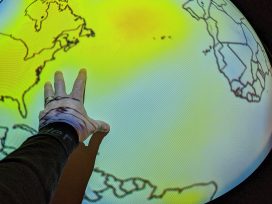
 Klaus K. Loenhart: For the Zero Landscape edition of GAM, landscape and the environment, often perceived as the seemingly passive background to our cultural endeavours, are elevated to the status of a protagonist. In your own work “on the seemingly passive”, how did you arrive at your position of a political ecology of things and matter?
Klaus K. Loenhart: For the Zero Landscape edition of GAM, landscape and the environment, often perceived as the seemingly passive background to our cultural endeavours, are elevated to the status of a protagonist. In your own work “on the seemingly passive”, how did you arrive at your position of a political ecology of things and matter?

